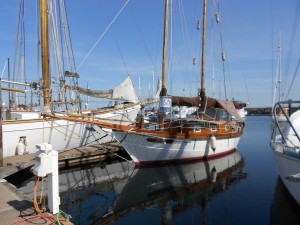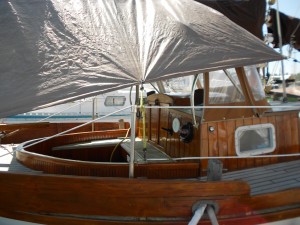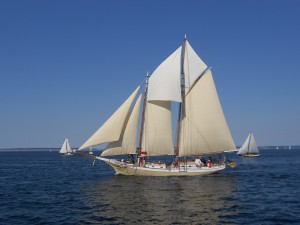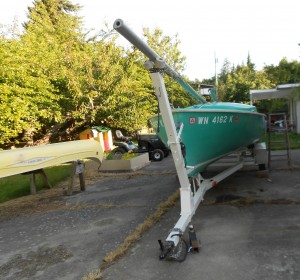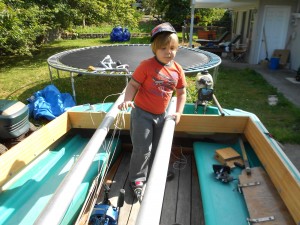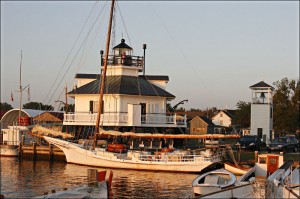There is no better place to be than on the water with a fresh breeze and the deck of a stout schooner beneath your feet. The solid way she moves in time with the waves matches the rhythm of life beating in a sailor’s bones. Saturday September 10, 2011 was a day filled with harmonic resonance for me. The dawn was blue and bright with promise as I prepared to leave for the Wooden Boat Festival in Port Townsend, Washington. I had a plan. My goal was to spend as much of the festival as possible on the water.
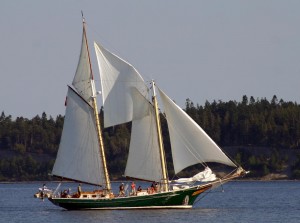
The schooner Windjammer under full sail.
As much as I enjoyed last year’s festival it involved a lot of work that kept me pinned to the land. I cruised the show taking pictures and shooting video. I had never made a serious attempt at videography and my journalistic skills are still a work in progress. It required a lot of focus and I found myself at the end of the day without having gone sailing, rowing, paddling or even wading on the beach. This year I resolved to get out on the water and experience the show in the ultimate participatory fashion.
A festival based on boats should, after all, give one the experience of watercraft in their God given medium. My plan was to attend the skipper’s meeting for the Northwest Schooner Cup and try to hitch a ride on one of the big boats as crew. Failing that I would rush over to Pygmy kayaks and the Chesapeake Light Craft display to sign up for paddling their products around the marina. Also, there is usually one or two San Francisco Pelicans pulled up on the beach in front of the Northwest Maritime Center. I have been wanting to sail one for nostalgia sake and which would delight me through and through. It would also provide a bit of blog fodder.
As it turned out hitching a ride was surprisingly easy. I have tried this method of catching a ride on a sailboat before with success but there can be some competition and captains tend to pick people they know. Not so that day. I was the only one and could have ended up on any one of three schooners whose captain’s needed to fill out a crew. I ended up getting the nod from Ashley Kerr skipper of the 72′ schooner Windjammer from Brisbane Australia. The phrase that rang in my mind was “he shoots, he scores.” Ashley told me to meet him at the end of the pier at one o’clock. That gave me time to explore the vendors. I also took a ride on a steam launch belonging to the Center For Wooden Boats on Seattle’s Lake Union.
I was on the float at the end of the pier promptly at one where I met Ashley just arriving in an inflatable dinghy. Four other recruits showed up and we huddled up in the tender for the short ride to Windjammer. Approaching the vessel from the water was a visual treat. She looked every inch the traditional coasting schooner with every detail as ship-shape as a sailor could want. On deck she had a solid feel and looked to be built with comfortable cruising as a large priority. We were soon introduced to Ashley’s wife Cathie.
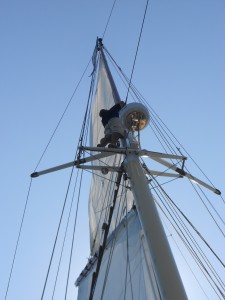
It wasn’t long before we began to raise sails and prepare to get under way. The assembled strangers that passed for a crew began to sort themselves out as the skipper assigned various tasks to us. The main went up first followed by the foresail. The foredeck would require the most crew activity because of the necessity of tending sheets during tacking and jibing maneuvers. With the anchor taken up we powered into the wind and soon raised the staysail and a large jib which was on a roller furler.
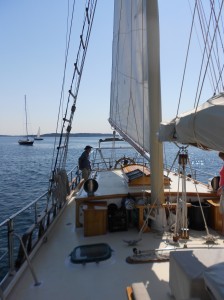
The race was not scheduled to start until three o’clock so we had a good amount of time get used to the basics of working the ship. I found myself stationed aft with the skipper handy to the mainsheet. It was the perfect position for observing the race and shooting pictures and video. We headed up the bay to the upper end of the course and made our way back to the start in plenty of time. In fact the start was delayed and we spent some time playing dodge’em with a beautiful assembly of schooners large and small. I will confess that racing is not my favvorite thing to do with a sailboat but as an excuse to bring together so many fine examples of the boatbuilder’s art it is first rate.
For a dyed in the wool schooner watcher there is no better observation post than from the deck of a well-found sailing vessel. The star of a sailboat race can seem like a parade of pandemonium. The NW Schooner Cup race features vessels in a wide range of sizes from the schooner Martha (84′ long) down to what appeared to be a Bolger light schooner at 23.5 feet. All participants in the race were smartly handled and the fleet eventually headed for the first mark with a freshening breeze.
Handling a vessel of Windjammer’s size takes some coordination. It was obvious that Ashley new his vessel well and his patient attention to the ship and the working of the crew eventually smoothed out the processes of tacking and jibing. I would like to say we did well in the race but for the most part we served as a perfect platform for viewing the bigger boats with their more practiced crews as they made the most of wind and tide. By the time we turned the fourth mark the wind began to slacken and lose the consistent strength it had showed earlier in the day. The front of the fleet began to cross the finish line as the rest began to slow down to the crawl typical of heavy displacement vessels in light winds.
Racing under sail is a persnickety process. When the wind is moving like a freight train it is important to trim the sails with many small adjustments to fine tune their shape for maximum pulling power. When the air slows to a gentle caressing force the sails must be trimmed with many small adjustments to fine tune their shape for maximum pulling power. We scanned the surface of the water for tell-tale differences in color and texture showing the presence of wind or lack thereof. Mostly it was lacking but we eventually began to find some again as we neared the finish line. With about two minutes to go the commitee boat did it’s duty with a series of blasts on a horn signalling the end of the race. It was no longer possible to qualify for a finishing position but perhaps that was a merciful ending to the enterprise. We pressed on crossing the line with the skipper giving the comittee boat a return blast from his own horn.
As we prepared to tack for a beat homeward skipper belayed the order and decided to keep on sailing for awhile longer as the breeze was returning and Cathie had placed a spread of snacks and several bottles of wine on the cabin top. Everyone gathered around and made short work of the cheese, chips, and salsa. The wine warmed everyone up and caused a steadier flow of conversation than I had heard all day. Pretty soon we were headed back to the anchorage with the process of furling sails and making everything on deck ship-shape just in time to drop the hook.
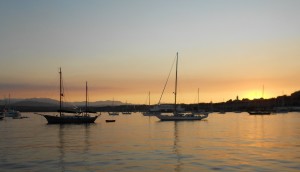
More lively conversation ensued as the sun went down. The chill of the evening drove us all below where we gathered around the galley table to swap opinions and stories centered around boats and travel. A warm cabin has a way of making instant friendships. What is a festival for if not to bond people with the cement of shared interest? The Wooden Boat Foundation outdid itself in 2011. It proved that they really know how to make an exceptionally fine festival.


